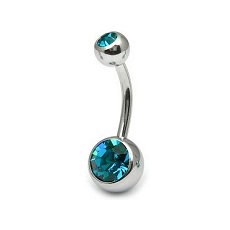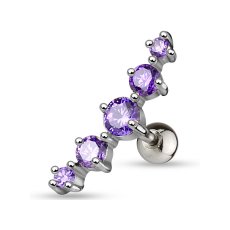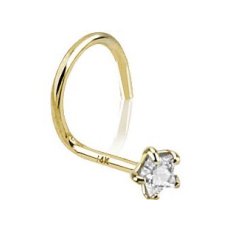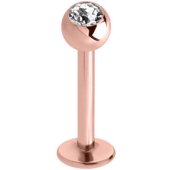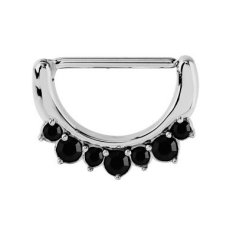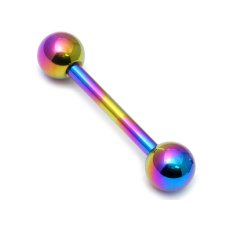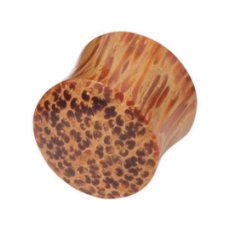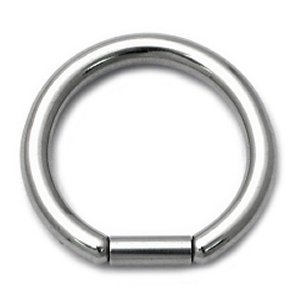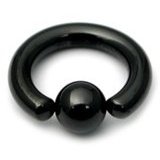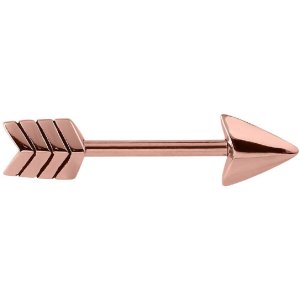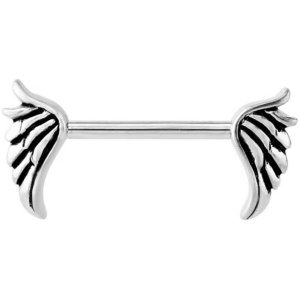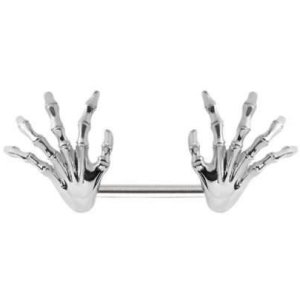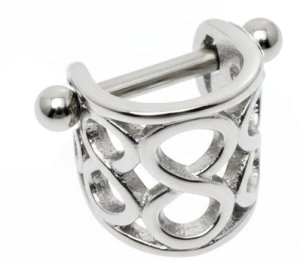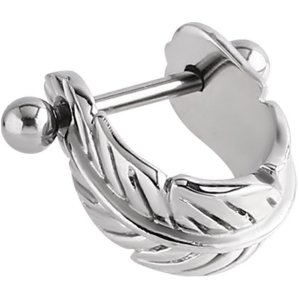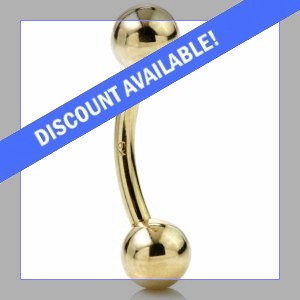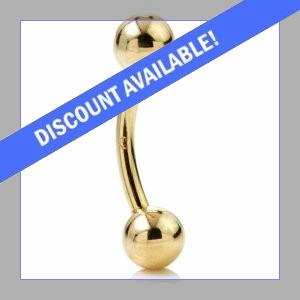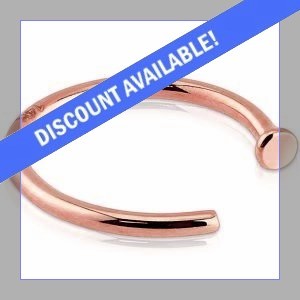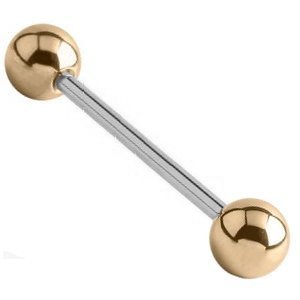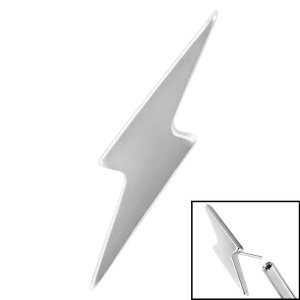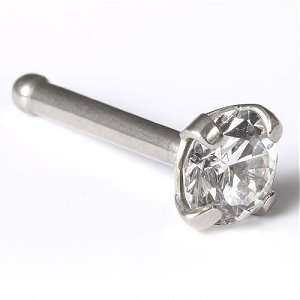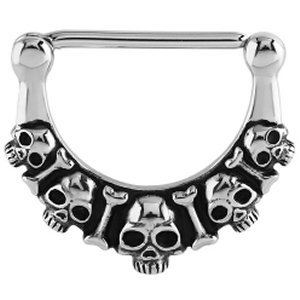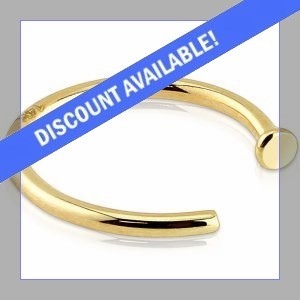What Size Do I Need?
Please order sizes carefully - it's really important that you wear the correct gauge and size of jewellery in your piercing. If you are in any doubt as to what size you need, please take a look at the pictures and information below.
In addition to the information below, we recommend that you read Choosing the Correct Size of Body Jewellery which is packed full of even more tips and helpful advice.
If you are still unsure what size to choose, please do Ask Us Here and we will do our very best to help you.
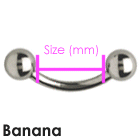 | 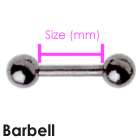 | 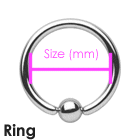 |
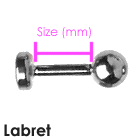 | 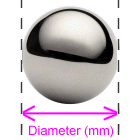 | 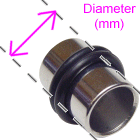 |
How Do I Know What Gauge My Piercing Is?
The gauge refers to the thickness of your piercing hole. In terms of the jewellery, the gauge refers to the thickness of the shaft or stem - most importantly, the section of the jewellery which sits inside your piercing. The shaft can be curved or straight. On this page you will find details of the standard gauge for various types of piercing, however if you are in any doubt as to the gauge of your own piercing, one option would be to contact your piercing studio who should be able to advise you with regard to which gauge you were pierced with. A trained eye can also identify the gauge of a bar with a glance and so it might be worth paying a visit to your studio.
An example of a gauge measurement is 1.6mm: this is the gauge of a standard belly bar. If you were to try and insert a bar with a gauge thicker than 1.6mm into your navel piercing, you would likely suffer some discomfort. On the other hand, if you were to wear a bar which had a thinner gauge than 1.6mm - say 1.2mm for example - there is a chance that in time the gauge of your piercing would be reduced to 1.2mm. This would be fine if you intended to keep wearing 1.2mm gauge bars in your piercing, however if you decided that you wanted to wear a standard 1.6mm gauge belly bar again you would probably experience some discomfort when inserting a bar of that gauge. It certainly wouldn't be impossible to do, but you would need to take your time and the use of some healing oil would soothe your piercing whilst aiding the slow insertion of the new, thicker bar.
How Do I Know What Size My Piercing Is?
The first two things to note are that the 'size' generally refers to the length of your piercing and that the size is a completely separate measurement to the 'gauge' described above. Another way of describing the size is the 'distance between the two piercing holes'. To give you an example, let's say that the barbell in the above 'Barbell' illustration is 10mm (remember, the measurement is calculated without including the balls). If you removed one of the balls from the barbell, inserted the barbell into your piercing and then screwed the ball back on, you would then be able to check whether you are wearing the correct size: if you found that there was 2mm of the bar section showing, you would probably consider swapping the barbell for an 8mm one to get a perfect fit. However, you wouldn't want to wear a bar smaller than 8mm because it would pinch your piercing with the likelihood of soreness and related problems.
What is the Average Size?
We often get asked this and yes, we can certainly tell you the average size of a particular piece of piercing jewellery. However, it wouldn't really mean anything to you because we don't know (and you likely don't know) whether your piercing is of average size or not. All piercings vary in size from person to person and so we can only do the next best thing which is to provide you with as much help and information as possible.
Does My Existing Jewellery Fit Me Properly?
Your piercing jewellery should never pinch your skin. If it does, you should change your bar to a larger size to avoid the possibility of soreness and infection.
Many people, on the other hand, wear bars which are too large for their piercings. If you have more than a couple of millimetres of the bar (shaft/stem) on display, why not consider changing the bar to a smaller size? There is such a wide range of sizes available these days that there is usually no reason to have any part of the bar on display - unless that's the way you like it, of course, and there is nothing wrong with that.
If you are in any doubt as to which size of piercing jewellery you require, just measure your existing jewellery using the appropriate illustration above as a guide.
Changing to a Different Shape of Bar
If you wish to change to a different shape of bar (ie, you want to wear a curved banana bar instead of a straight barbell) bear in mind that you may experience a little discomfort at first, as your piercing will naturally try to stay in the shape of your previous piece of jewellery.
With piercings located in softer areas of skin (such as the ear lobe or nipple) this usually isn't a problem, however some piercings located in harder areas (such as ear cartilage) may be affected by some discomfort whilst they are adapting to the shape of the new bar. This is entirely normal and any problems encountered will normally settle down in time.
Belly Bar Sizes
Belly bars have two main sizing aspects for you to take into consideration: the gauge and the size (both discussed above). The standard gauge for a belly bar is 1.6mm and all of our standard belly bars are 1.6mm gauge.
The 'size' refers to the distance between the top ball and the beginning point of the lower decorative part (see the 'Banana' illustration above). Whilst you are likely to only find size 10mm in the high street shops, many of our own belly bars are available in 6mm, 8mm, 10mm, 12mm, 14mm, 16mm and even longer, which means no more pinching or spare bits of bar showing. Simply choose your desired size by selecting from the 'Size' drop-down box. We know that many people need 6mm belly bars, along with sizes 14mm, 16mm and 18mm, and we are constantly striving to increase our selection of these sizes.
The screw-on top ball is measured by its diameter in millimetres (see the 'Diameter' illustration above). Generally speaking, the top ball on a belly bar is 5mm diameter, however if you have a specific requirement for a particular size of top ball, just ask us before placing your order and we will let you know if we can accommodate your request.
Ear Stud Sizes
Ear studs have two main sizing aspects for you to take into consideration: the gauge and the size (both discussed above). Most cartilage piercings are 1.2mm gauge, however this can vary depending on your piercer (it can also vary individually depending on the anatomy of your ear) so it's always good to check with your piercer wherever possible.
Screw-on balls are measured by their diameter in millimetres (see the 'Diameter' illustration above). Generally speaking, most balls on ear studs are either 3mm or 4mm, however this can vary from supplier to supplier.
Nose Stud Sizes
Nose jewellery is generally offered in four different shapes: corkscrew, L-shaped, straight pin and you can also wear a standard piercing ring. Please choose carefully as you may experience some discomfort if you change the shape of your jewellery (see Changing to a Different Shape of Bar above).
Nose jewellery has two main sizing aspects for you to take into consideration: the gauge and the size (both discussed above). . The standard gauge for a nose piercing can be either 0.8mm or 1mm and many of our nose stud designs are offered in a variety of gauges.
Lip Bar Sizes
Lip jewellery (often referred to as a labret or Madonna piercing) is generally offered in four different shapes: a labret bar, a straight bar (barbell), a curved bar (banana) and a ring. Please choose carefully as you may experience some discomfort if you change the shape of your jewellery (see above).
Lip jewellery has two main sizing aspects for you to take into consideration: the gauge and the size (both discussed above). . The standard gauge for a lip piercing can be either 1.2mm or 1.6mm and the majority of our lip jewellery is offered in both gauge sizes.
The 'size' depends on what shape of lip jewellery you choose. For example, the size of a straight lip barbell is measured as per the 'Barbell' illustration above. The size of a curved lip bar is measured as per the 'Banana' illustration above and the size of a lip ring is measured as per the 'Ring' illustration above.
Nipple Bar Sizes
Nipple jewellery is generally offered in three different shapes: a straight bar (barbell), a curved bar (banana) and a ring. Please choose carefully as you may experience some discomfort if you change the shape of your jewellery (see above).
Nipple jewellery has two main sizing aspects for you to take into consideration: the gauge and the size (both discussed above). The standard gauge for a nipple bar is 1.6mm and all of our standard nipple bars are 1.6mm gauge.
The 'size' depends on what shape of nipple jewellery you choose. For example, the size of a straight nipple barbell is measured as per the 'Barbell' illustration above. The size of a curved nipple bar is measured as per the 'Banana' illustration above and the size of a nipple ring is measured as per the 'Ring' illustration above.
Tongue Bar Sizes
Tongue bars have two main sizing aspects for you to take into consideration: the gauge and the size (both discussed above). . The standard gauge for a tongue bar is 1.6mm and all of our tongue bars have the standard gauge of 1.6mm.
The 'size' (or 'length') refers to the distance between the two balls (see the 'Barbell' illustration above). Whilst you are likely to only find sizes 12mm and 14mm in the high street shops, many of our own tongue bars are available in sizes as low as 6mm, right through to 20mm and beyond. This means no more excess bar showing! Simply choose your desired size by selecting from the 'Size' drop-down box.
The screw-on balls are measured by their diameter in millimetres (see the 'Diameter' illustration above). Generally speaking, the bottom ball on a tongue bar is either 5mm or 6mm, however if you have a specific requirement for a particular size of bottom ball, just ask us before placing your order and we will let you know if we can accommodate your request.
Eyebrow Bar Sizes
Eyebrow jewellery is generally offered in three different shapes: a straight bar (barbell), a curved bar (banana) and a ring. Please choose carefully as you may experience some discomfort if you change the shape of your jewellery (see above).
Eyebrow jewellery has two main sizing aspects for you to take into consideration: the gauge and the size (both discussed above). . The standard gauge for an eyebrow bar is 1.2mm and all of our standard eyebrow bars are 1.2mm gauge.
The 'size' depends on what shape of eyebrow jewellery you choose. For example, the size of a straight eyebrow barbell is measured as per the 'Barbell' illustration above. The size of a curved eyebrow bar is measured as per the 'Banana' illustration above and the size of an eyebrow ring is measured as per the 'Ring' illustration above.
Flesh Tunnel & Plug Sizes
Flesh tunnels and plugs are designed for people who want to stretch their ear lobe piercing. For some great tips and advice, why not read our very own guide How To Stretch Your Ear Piercing?
Flesh tunnels and plugs (and also stretchers and spirals) have just one sizing aspect for you to take into consideration: the gauge (described above). The gauge of your stretched ear piercing could start at 1.2mm and you could increase its size up to 50mm or beyond if that is what you want to do!
Please see the 'Diameter' illustration above, which shows you how a tunnel is measured. Plugs are measured in the same way, and stretchers use the same measurement but at their widest point only. Please note that the diameter of organic plugs and tunnels (wood, bone and horn, etc) can vary by up to 1mm.
Further Reading
Take a look at our helpful feature entitled Choosing the Correct Size of Body Jewellery. It's packed full of information designed to help you decide on the right size to buy.

